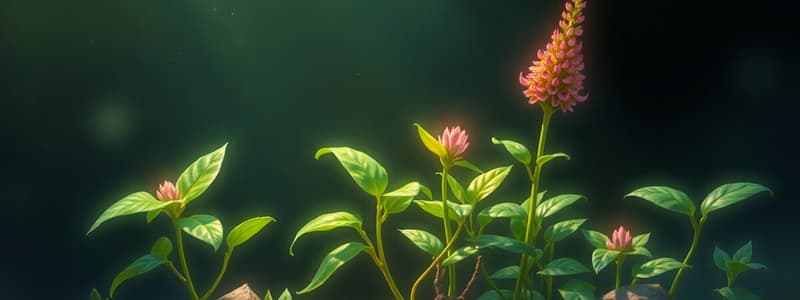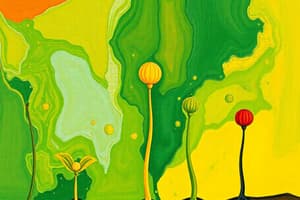Podcast
Questions and Answers
Which process is NOT associated with plant development?
Which process is NOT associated with plant development?
- Morphogenesis involving the acquisition of form and structure.
- The sequence of structural changes throughout the plant's life.
- Differentiation of cells for specific functions.
- The irreversible increase in the plant's overall size. (correct)
If a botanist is studying the increase in the diameter of a tree trunk, which type of growth is the focus?
If a botanist is studying the increase in the diameter of a tree trunk, which type of growth is the focus?
- Seedling development, as the plant establishes itself.
- Primary growth, due to the axillary buds activity.
- Secondary growth, which is controlled by lateral meristems. (correct)
- Primary growth, due to the apical meristems activity.
What is the key difference between primary and secondary growth in plants?
What is the key difference between primary and secondary growth in plants?
- Primary growth is driven by lateral meristems, while secondary growth is driven by apical meristems.
- Primary growth extends plant length, while secondary growth increases diameter. (correct)
- Primary growth occurs in roots, while secondary growth occurs in stems.
- Primary growth involves cell differentiation, while secondary growth involves morphogenesis.
A plant demonstrates significant branching from its stem. Which growth process primarily contributes to this?
A plant demonstrates significant branching from its stem. Which growth process primarily contributes to this?
During which stage of plant growth does the plant establish itself in the soil by growing roots and shoots?
During which stage of plant growth does the plant establish itself in the soil by growing roots and shoots?
What is considered a primary factor that drives seed germination?
What is considered a primary factor that drives seed germination?
If plant cells are undergoing differentiation, what is happening at the cellular level?
If plant cells are undergoing differentiation, what is happening at the cellular level?
A scientist observes a plant's apical meristems are highly active. What type of growth is most likely occurring?
A scientist observes a plant's apical meristems are highly active. What type of growth is most likely occurring?
What stage marks the transition of a plant from vegetative development to reproductive capability?
What stage marks the transition of a plant from vegetative development to reproductive capability?
Consider a plant that has just undergone morphogenesis. What has occurred within the plant?
Consider a plant that has just undergone morphogenesis. What has occurred within the plant?
What is the primary function of the apical meristem in plants?
What is the primary function of the apical meristem in plants?
Which phase of cell growth is characterized by cells increasing significantly in size?
Which phase of cell growth is characterized by cells increasing significantly in size?
What role does the lateral meristem play in plant development?
What role does the lateral meristem play in plant development?
During which phase of cell growth do cells undergo specialization to form complex tissues?
During which phase of cell growth do cells undergo specialization to form complex tissues?
Which measurement is NOT a direct indicator of plant growth characteristics?
Which measurement is NOT a direct indicator of plant growth characteristics?
How does the phase of elongation primarily contribute to a plant's survival?
How does the phase of elongation primarily contribute to a plant's survival?
What is the significance of cell division in the meristematic zone?
What is the significance of cell division in the meristematic zone?
Which of the following sequences accurately represents the chronological events in plant development?
Which of the following sequences accurately represents the chronological events in plant development?
How do differentiated cells contribute to the overall function of a plant organ?
How do differentiated cells contribute to the overall function of a plant organ?
A scientist is studying a new plant species and observes it lacks lateral meristems. What is the most likely characteristic this plant will be unable to exhibit?
A scientist is studying a new plant species and observes it lacks lateral meristems. What is the most likely characteristic this plant will be unable to exhibit?
Flashcards
Plant Growth
Plant Growth
Irreversible increase in plant size, including cell size and mass.
Plant Development
Plant Development
Sequence of structural changes in a plant's life, from seed to aging.
Morphogenesis
Morphogenesis
Acquisition of form and structure during plant development.
Cell Differentiation
Cell Differentiation
Signup and view all the flashcards
Primary Growth
Primary Growth
Signup and view all the flashcards
Secondary Growth
Secondary Growth
Signup and view all the flashcards
Seed Germination
Seed Germination
Signup and view all the flashcards
Seedling Development
Seedling Development
Signup and view all the flashcards
Adult Plant Formation
Adult Plant Formation
Signup and view all the flashcards
Branching
Branching
Signup and view all the flashcards
Apical Meristem
Apical Meristem
Signup and view all the flashcards
Lateral Meristem
Lateral Meristem
Signup and view all the flashcards
Phase of Division
Phase of Division
Signup and view all the flashcards
Phase of Elongation
Phase of Elongation
Signup and view all the flashcards
Phase of Differentiation
Phase of Differentiation
Signup and view all the flashcards
Growth Characteristics
Growth Characteristics
Signup and view all the flashcards
Development Characteristics
Development Characteristics
Signup and view all the flashcards
Meristems
Meristems
Signup and view all the flashcards
Study Notes
- Growth is defined as the irreversible and permanent increase in size of the plant, its parts, or an individual cell, including factors like cell size, tissue expansion, and overall plant mass
- Development refers to a sequence of qualitative structural changes occurring throughout a plant's life cycle, from germination to senescence (aging)
Development:
- Morphogenesis: the acquisition of form and structure
- Transformation of generalized cells into specialized ones
Stages of Plant Growth:
- Seed Germination is the initial stage, in which the seed absorbs water, breaks dormancy, and starts metabolic activities
- Seedling Development occurs when the seedling grows roots and shoots, thus establishing itself in the soil
- Adult Plant Formation happens when a plant attains maturity with fully developed tissues, organs, and reproductive structures
- Apical Meristem: Located at the tips of roots and shoots. They are Responsible for primary growth, increasing the plant's length
- Lateral Meristem: Found along the sides of stems and roots, and responsible for secondary growth, increasing the plant's girth
Phases of Cell Growth:
- Phase of Division (Meristematic Phase): Involves mitotic cell division in the meristematic zone and produces new cells for growth
- Phase of Elongation: Cells increase in size, up to 10 times their original length, resulting in root penetration deeper into the soil and contributing to the size and length of plant tissues
- Phase of Differentiation (Maturation): Cells undergo specialization based on their position in the organ, and differentiated cells form complex tissues like vascular bundles and perform specific functions
- Primary Growth occurs first and extends plant length above and below ground and is Driven by apical meristems
- Secondary Growth occurs after primary growth, increasing diameter and strength
- It's controlled by lateral meristems and includes growth from axillary/lateral buds, contributing to plant branching
- Plant growth can be measured by increases in fresh or dry weight, leaf area, and plant height
Development Characteristics:
- Progression of chronological events like: germination, seedling emergence, leaf appearance, branching, flowering, fruiting, seedling, maturation, senescence(aging)
- Light is essential for photosynthesis, regulating stomata, and floral induction
- The intensity and quality of light affects plant processes Water constitutes 90% of the plant body
- Necessary for cell elongation and expansion, photosynthesis, nutrient transport, and seed germination
- Temperature is a key driver for metabolic processes like transpiration, photosynthesis, and flowering
- Plants require macronutrients (e.g., nitrogen, phosphorus, calcium) and micronutrients (e.g., iron, boron, manganese)
- Deficiency in even one nutrient can lead to stunted growth and susceptibility to diseases
- The plant growth curve represents growth plotted against time
Phases of plant growth curve:
- Lag Phase: Initial slow growth period with a Growth percentage <25%, seedling emergence, plant establishment
- Log Phase (Exponential Phase): Rapid growth phase with a Growth percentage from 25-70% indicating leaf production, branching, tillering
- Diminishing Phase: Slower growth phase with a Growth percentage from 70-85%, indicating flowering, seed production
- Stationary Phase: Growth ceases at a growth percentage of 85-100%, indicating ripening, maturity, senescence
Plant Tissue systems:
- Dermal Tissue System forms the "skin" of the plant, primarily for protection and generally as a single layer of cells, predominantly parenchyma cells
- Epidermis is a single layer of tightly packed cells covering plant surfaces for protection against water loss and pathogens & secretes a waxy coating called the cuticle on leaves to minimize water loss
- In plants undergoing secondary growth, the epidermis is replaced by the periderm
- Periderm is found in stems of plants with secondary growth, replacing he epidermis
- The Cork Cambium (Meristematic) produces cork (phellem) outward and phelloderm inward with the Cork (Phellem) provides a protective layer that prevents water loss and provides insulation
- Phelloderm is an inner layer supporting the cork cambium
Ground Tissue System:
- Constitutes the majority of the plant body and functions for Photosynthesis, storage, and structural support
- Parenchyma are living cells at maturity performing metabolic activities like photosynthesis, food storage, and regeneration
- Wound healing and organ regeneration occurs due to their ability to divide
- Subtypes: Chlorenchyma contains chloroplasts for photosynthesis
- Aerenchyma: contains large air spaces for gas exchange
- Collenchyma are living cells with unevenly thickened walls, providing flexible support Found in young stems and Angular, Lamellar & Lacunar
- Sclerenchyma are non-live cells with thick, Lignified secondary walls that provide strength and support to mature plant parts
Functions of Types:
- Fibers are long slender cells occurring in bundles (e.g, hemp, flax) while Sclereids are Short, irregularly shaped cells, present in seed coats & nut shells
- Vascular Tissue System is specialized for the transport of water, nutrients, and food that secondarily provide structural support
Composition:
- Xylem functions in conducting water and dissolved minerals with Principal cells: Tracheids and vessel elements (Hollow, non-living cells)
- Addition cells: Parenchyma and sclerenchyma
- Phloem functions to transport food (mainly sucrose) with Principal components: Sieve tubes and companion cells
- Additional Phloem fibers and parenchyma
Plant Cell:
- Protoplasm is the living content of the cell, consisting of The Nucleus & The Cytoplasm
- Nucleus: the control center for cell functions while Cytoplasm is a gel-like matrix where organelles are suspended.
- The cell wall surrounds the protoplasm and provides structural integrity to the plant
- Made predominantly of cellulose, a polysaccharide formed by thousands of glucose molecules.
Growth:
- A growing plant cell secretes a thin primary cell wall that stretches as the cell enlarges
- When growth ceases, additional layers called the secondary cell wall develop, which have a different chemical composition and enhance strength
Types of Permanent Tissue: Ground, Vascular, and Secretory
- Secretory Tissue contains resins, oils and mucilage.
- Specialized cells for production and secretion of substances like resins, oils, and mucilage and those types include internal and external
Tissues:
- Internal Secretory Tissues include Resin & Oil Vessels (Ducts surrounded by epithelial cells secreting essential oils and resins found in citrus plants) and is formed through a process called Lysigeny (dissolving cells)
- Laticifers: Cells or series of cells containing latex (a characteristic fluid)
- External Secretory Tissues include Hydathodes (found in aquatic plants) and Digestive glands, found in insectioverious plants) & Nectaries (found in flowers)
- The rhizosphere is the thin soil region surrounding a plant’s root hair where interactions occur between roots and microorganisms
- It consists of three zones, defined by their proximity to the root: Endorhizosphere, Rhizoplane, and Ectorhizosphere
Layers of Rhizosphere:
- Endorhizosphere includes the cortex and endodermis, where microbes occupy free spaces between cells
- Rhizoplane is adjacent to the root, including the epidermis and mucilage
- Ectorhizosphere is the outermost zone extending into bulk soil
- Root Exudates are a broad term including mucilages and soluble compounds and polysaccharide-rich, viscoelastic gels with adhesive properties
- Rhizodeposits are substances imparted by roots to the surrounding soil
Components of Rhizodeposits:
- Loss of cap and border cells
- Loss of soluble root exudates & volatile organic carbon and carbon to symbionts as well as due to death
Carbon Released:
- Internal Secretory tissues which influences chemical, physical, and biological processes
- Roots release 10-250mg of carbon per gram of root with its organic forms influencing chemical, physical, and biological processes in the rhizosphere
- The composition and amount of compounds released depend on different factors
Factors of Plant type:
- Climatic conditions & nutrient deficiencies or toxicities
- Root hairs are found a few centimeters back from root tips and Absorbs water and nutrients,
- Die after about 3 weeks, creating a compost-like environment
Microbe-Plant Relationships In The Rhizosphere:
- Higher root carbon release leads to microbial competition
- Rhizobia Bacteria: Convert atmospheric nitrogen (N₂) to nitrate, residing in root nodules of legumes
- Mycorrhizal Fungi: Symbiotic association between soil and fungi of two types: Ectomycorrhiza and Endomycorrhiza
- Plant Growth-Promoting Rhizobacteria: Bacteria colonizing roots to enhance growth
Future Cropping Systems:
- Plant-based human food include, Wheat, rice, maize & soybean providing Providing over 50% of plant-based human food while Current crops rely on long-distance transportation to markets
- The vulnerability of supply chains raise the need for resilient supply that that can feed diverse populations while dealing with climate change
- Needs for sustainable agriculture include alternative aquaculture feeds (fish instead of plants) that can utilize locally sourced feeds to avoid major crops Thousands of underutilized plants have potential as future crops
Requirements for Future:
- Research to integrate field studies, lab experiments, community practice
- Need to diversify and develop crops with minimal input
- Developing crops that can thrive on poors soils as well as promoting local diets
- Connection between knowledge networks and foster connections betweek commmunities for more collaboration.
Improve Crops:
- Boost natural ecosystems' ability to fix carbon by enhanceing Yielding & tolerance of crops.
- Develop regenerative crops and chemicals derived from medicinal plants
- Carbon Fixation: ability to fix carbon to support environmental sustainability
Studying That Suits You
Use AI to generate personalized quizzes and flashcards to suit your learning preferences.
Related Documents
Description
Overview of plant growth focusing on irreversible size increase and structural changes during its life cycle. Includes seed germination, seedling development, adult plant formation and apical meristem. Covers morphogenesis and cell specialization.





